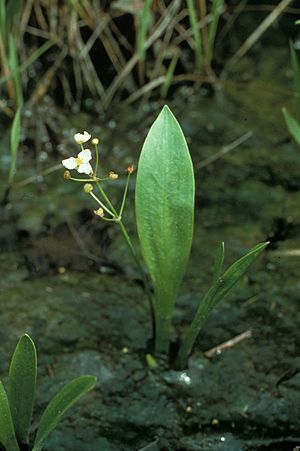Bunched arrowhead facts for kids
Quick facts for kids Bunched arrowhead |
|
|---|---|
 |
|
| Conservation status | |
| Scientific classification | |
| Genus: |
Sagittaria
|
| Species: |
fasciculata
|
The Bunched Arrowhead (scientific name: Sagittaria fasciculata) is a special plant found in wet, marshy areas. It's also known by other names like duck potato or Indian potato. This plant has edible parts called tubers, which are like small potatoes that grow underground. Long ago, Native Americans collected these tubers as an important food source. Sadly, the Bunched Arrowhead is now an endangered species. This means it's very rare and needs protection to survive. It was officially listed as endangered on July 25, 1979.
What Does the Bunched Arrowhead Look Like?
The Bunched Arrowhead is a small plant, usually growing up to about 35 centimeters (14 inches) tall. It's a perennial herb, meaning it lives for more than two years. Some of its leaves grow underwater. These leaves are long, thin, and round. Other leaves grow above the water. These are flat and shaped like an egg or a spearhead.
Where Can You Find It?
The Bunched Arrowhead is very rare. It's only found in a few specific places in the United States. You can find it in two counties in North Carolina: Henderson and Buncombe. It also grows in two counties in South Carolina: Greenville and Laurens.
Where Does It Like to Grow?
This plant prefers to live in wet areas where water slowly seeps through the ground. It doesn't like fast-moving water. The Bunched Arrowhead also likes shady spots. It grows best in sandy soil that has some clay in it.


